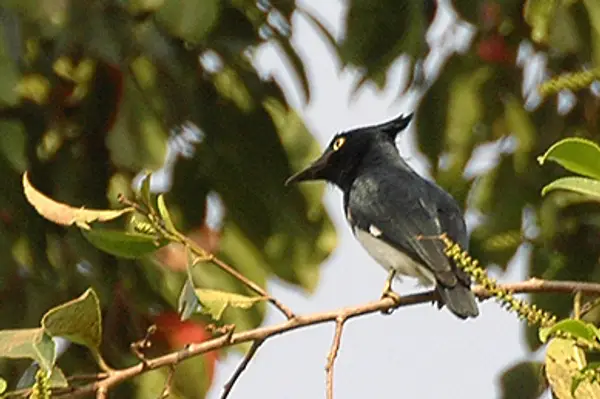Elephant (Elephantidae)
“Spends around 22 hours a day eating!”
Scientific Classification
- Kingdom: Animalia
- Phylum: Chordata
- Class: Mammalia
- Order: Proboscidea
- Family: Elephantidae
Their conservation status is categorized as “Near Threatened,” indicating they face a risk of becoming endangered if their population decline continues.
Primarily found in two regions:
- Africa
- Asia
Main Prey: Grass, fruit, roots.
Fun Fact: Spend around 22 hours a day eating!
Distinctive Feature: They are known for their large body size and long trunk.
Habitat: Inhabit rainforests and flood plains.
Diet: They are herbivores.
Average Litter Size: Typically give birth to one calf at a time.
Lifestyle: Social animals and live in herds.
Favorite Food: Grass.
Type: They are mammals.
Slogan: “Spends around 22 hours a day eating!”
Physical Characteristics:
- Color: Grey.
- Skin Type: Their skin is like leather.
- Top Speed: Run at speeds up to 25 mph.
- Lifespan: They generally live between 55 to 70 years.
- Weight: Adult typically weigh between 3,000kg to 5,400kg (6,500lbs to 12,000lbs).
- Height: Their height ranges from 2m to 3.6m (7ft to 12ft).
These majestic creatures display a wide array of intricate behaviors, some of which bear striking resemblances to our own, while others are entirely their own. Their behavior, anatomy, and cognition have become the focus of intensive scientific study, sparking ongoing fascination in human culture, notably in Indian, Sumatran, and certain African mythologies and folklore.
However, despite their cultural significance and biological marvel, face a grave threat. Decades of poaching and habitat destruction have pushed them to the brink of extinction. Without significant efforts to safeguard their habitats and combat illegal hunting, these magnificent animals may tragically disappear from our world.
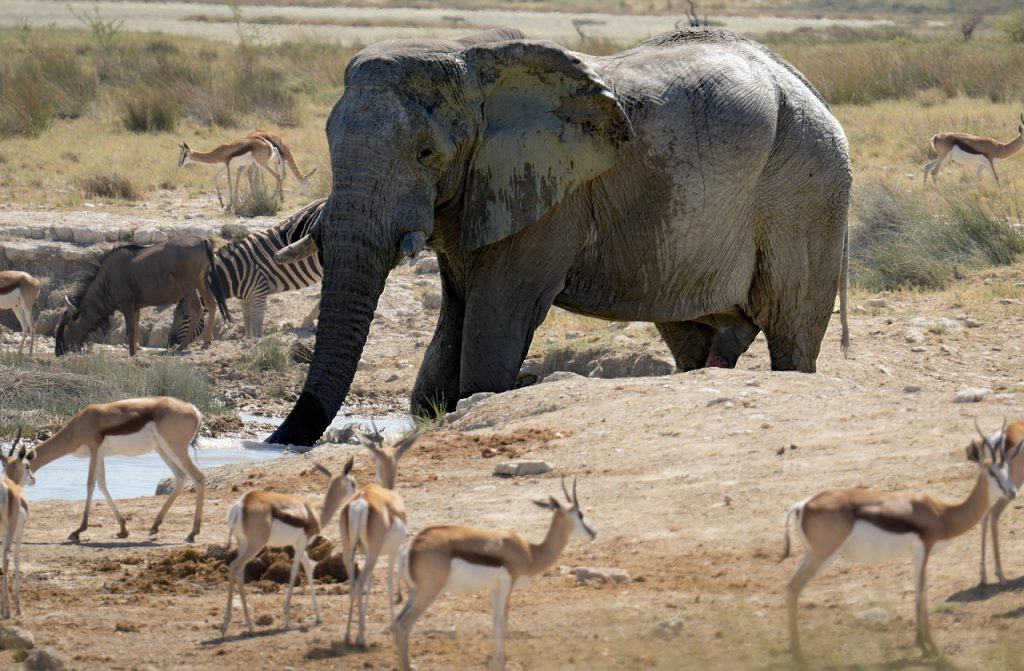
5 Incredible Elephant Facts!
- Exceptional Intelligence: Among the most intelligent creatures on Earth. They demonstrate self-awareness and recognition, with some even using tools, such as branches to swat flies. Their capacity to learn and remember details is remarkable. While there’s ongoing debate about whether they mourn their dead, undoubtedly exhibit profound emotions.
- Powerful Vocalizations: Communicate through a variety of vocalizations, including a distinctive low rumble that can carry for up to 5 miles, allowing them to maintain contact over long distances.
- Pachyderm Origins: The term “pachyderm,” derived from the Greek word “pachydermos” meaning “thick-skinned,” refers to mammals with tough hides. Surprisingly, despite sharing this characteristic, rhinos, and hippos are not closely related.
- Incredible Strength: Strength is awe-inspiring; they can carry loads of up to 7 tons, making them one of the strongest animals on the planet.
- Population Decline: Once, Africa alone was home to an estimated 26 million. Today, however, the global population has dwindled to less than half a million, primarily due to poaching and habitat loss, highlighting the urgent need for conservation efforts.
Scientific Name
The family is scientifically known as Elephantidae. Within this family, there are two living genera. The genus Loxodonta comprises two species: the African bush and the African forest. On the other hand, the genus Elephas includes only one living species. However, can be further subdivided into several distinct subspecies, such as the Indian, Sumatran, Borneo, and Sri Lankan elephants.
Beyond the living species, the fossil record reveals a rich diversity of species, including the woolly mammoth, which roamed the Earth during the last ice age. These ancient relatives of modern contribute to our understanding of the evolutionary history and ecological roles of this remarkable group of animals.
Types
- African Forest Elephant (Loxodonta cyclotis):
- Found in the forests of southern and central Africa.
- Slightly smaller than the African bush elephant.
- Features rounder ears, straighter tusks, and more toenails compared to its savannah-dwelling cousin.
- African Bush Elephant (Loxodonta africana africana):
- Inhabits the savannahs of western, central, eastern, and southern Africa.
- Can weigh up to 12,000lbs, making it one of the largest land mammals.
- Borneo Elephants (Elephas maximus borneensis):
- Evolved separately on Borneo, making them distinct from other Asian elephants.
- The smallest of all Asian elephants.
- Known for having straighter tusks and longer tails on average.
- Indian Elephants (Elephas maximus indicus):
- Found primarily in India and surrounding regions.
- Females may occasionally have small tusks.
- Darker in color compared to Sumatran elephants but lighter than Sri Lankan elephants.
- Stomachs are proportionate to their body size.
- Sri Lankan Elephants (Elephas maximus maximus):
- The largest of the three Asian elephant subspecies.
- Darker in color compared to other subspecies.
- Like Indian elephants, they have 19 pairs of ribs.
- Sumatran Elephants (Elephas maximus sumatranus):
- The lightest of Asian elephants.
- Have 20 pairs of ribs.
- Exhibit the least amount of discoloration among the three subspecies.
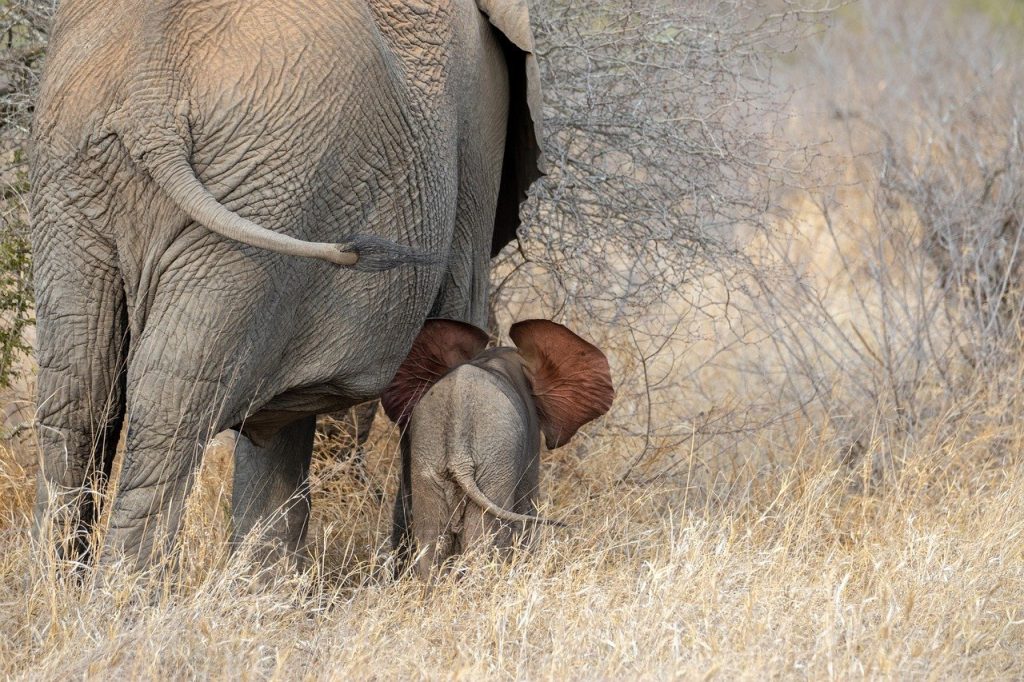
Appearance
Elephants possess a unique set of features that set them apart from all other creatures. Their massive bodies, sturdy legs, slender tails, rounded ears, and robust trunks define their distinctive appearance.Boast ivory tusks, which are actually elongated incisor teeth. These tusks serve multiple purposes, including digging for food and water, self-defense, and lifting heavy objects effortlessly. Complementing their tusks are four molars, each resembling the size of a brick, facilitating efficient chewing.
Their ears are particularly remarkable adaptations, granting them unparalleled hearing abilities among terrestrial animals. Elephants can detect calls from fellow elephants from distances as far as 2.5 miles away, thanks to their acute auditory senses.
Size is perhaps the most defining characteristic. Towering at around 10 feet tall and stretching between 18 to 24 feet in length, these majestic creatures weigh an astounding 4 to 8 tons on average. The largest elephant on record stood an astonishing 13 feet tall and weighed an impressive 12 tons. Much of their formidable stature is owed to their expansive skull, which supports their large ears, tusks, and trunk. Despite their imposing size, elephants maintain agility and strength, aided by specialized skeletal structures.
In addition to their size, elephants exhibit various physical distinctions. Asian elephants, for instance, are generally smaller than their African counterparts and often have reduced tusk growth. The Borneo regarded as the smallest subspecies, is occasionally referred to as the pygmy elephant due to its diminutive size. On the other hand, Sri Lankan elephants display a lower propensity for tusk growth compared to other species and subspecies.
The elephant’s trunk, a remarkable fusion of its nose and upper lip, serves as a versatile tool with a multitude of functions related to touch, smell, and communication. Equipped with finger-like projections at the tip the trunk exhibits remarkable dexterity, capable of grasping objects as delicate as a piece of straw. Remarkably, the trunk comprises approximately 150,000 individual muscle fibers, devoid of bones or cartilage and containing minimal fat. This muscular arrangement enables precise movements, defying the elephant’s bulky appearance.
The elephant’s large, rounded ears play a crucial role in regulating its body temperature. The size of the ears corresponds to the density of blood vessels they house, facilitating the efficient release of excess body heat into the environment. This cooling effect is further enhanced when the elephant flaps its ears, maximizing heat dissipation.
Evolution
Before the emergence of modern elephants, the prehistoric world was inhabited by fascinating creatures known as Gomphotheres. These tusked herbivores roamed Africa, Eurasia, and the Americas during the Miocene, Pliocene, and Pleistocene epochs, feasting on vegetation.
By the early Pleistocene, however, Gomphotheres had vanished from the Earth. Yet, they left behind a legacy, giving rise to the elephantids, the lineage from which modern elephants descended. Around 5 million years ago, during the transition from the Miocene to the Pliocene, the genus Loxodonta emerged in Africa. Shortly thereafter, the genera Elephas and Mammuthus followed suit.
Among these lineages, Loxodonta remained predominantly in Africa, while Mammuthus expanded its territory into Eurasia. Elephas, on the other hand, not only spread across Eurasia but even ventured into North America.
Throughout the Pleistocene epoch, Elephas diversified further, giving rise to Elephas platycephus, the precursor. Meanwhile, Mammuthus evolved into Mammuthus primigenius, better known as the woolly mammoth. Interestingly, the Asian elephant is the closest living relative of this shaggy giant, which succumbed to extinction approximately 4,000 years ago.
Over time, these ancient creatures underwent significant transformations, evolving into the majestic behemoths we recognize today. Changes in diet led to alterations in tooth size, with upper second incisors evolving into tusks. Their necks shortened to support enlarged heads, necessitating the lengthening of their trunks.
The outcome? The magnificent giants that reign as the largest land mammals in Africa and Asia.
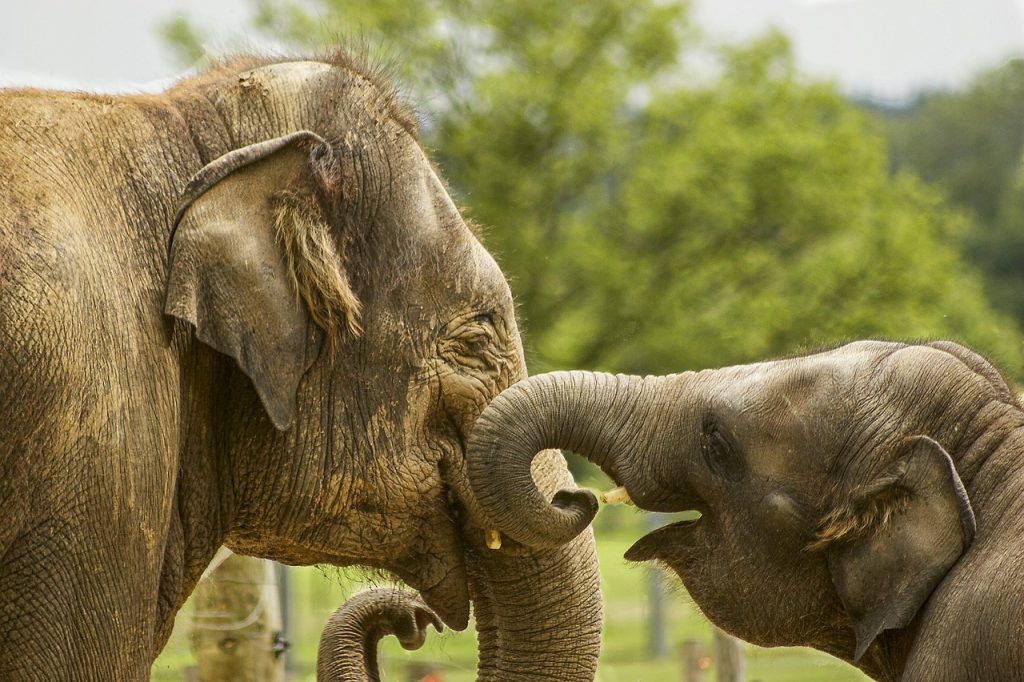
Behavior
The social dynamics revolve around tight-knit herds and smaller groups. Typically, an elephant herd comprises closely related female cows and their offspring, led by a single matriarch. This wise leader guides the group in finding food, water, shelter, and avoiding threats. Interestingly, the eldest daughter often assumes the role of matriarch after her mother’s passing. A typical herd consists of approximately 10 individuals, but if the group grows too large, some elephants may splinter off to form new semi-independent groups.
Male bulls, on the contrary, either wander solo or band together in bachelor groups with distinct dominance hierarchies. These males are more likely to gather during times of scarcity or in the face of danger, only interacting with females during mating seasons.
Communication among elephants is intricate, with the trunk playing a pivotal role. A raised trunk signifies a greeting, while lower-ranked members may offer a conciliatory gesture by placing their trunk tip into the mouth of a higher-ranked individual. Despite their iconic trumpeting calls, many of their vocalizations are too low-pitched for human ears to detect. They also produce a distinct growling noise from their stomachs, signaling their well-being to others.
Feeding occupies a significant portion of an elephant’s day, with some individuals spending up to 18 hours foraging for food. The remaining time is dedicated to activities such as sleeping, bathing, self-grooming, and social bonding. Play and friendly sparring with peers are common behaviors among young elephants.
In the wild, elephants sleep for only about two hours per day, often while standing up to remain vigilant against potential predators. However, in captivity, where predators are absent, they may sleep for up to six hours per night, often lying down for rest.
Habitat
Elephants are adaptable creatures found in a variety of habitats, including savannas, deserts, marshlands, and forests near rivers. Their distribution spans across sub-Saharan Africa and South Asia. The specific subspecies—Indian, Sumatran, Borneo, and Sri Lankan elephants—typically correspond to distinct geographical regions within these areas.
However, the current range is notably diminished compared to their historical extent. For instance, the Asian elephant’s range once extended from Syria to China, covering vast expanses of land. Similarly, the African forest elephant now occupies only a fraction of its former territory, confined to a small area within the Congo basin in western Africa. This reduction in habitat highlights the pressing conservation challenges facing these magnificent creatures.
Diet
Elephants are strict herbivores, relying solely on vegetation for their nutritional needs. They have voracious appetites, consuming an astounding amount of food to sustain their massive bodies. On average, an elephant devours up to 330 pounds of vegetation daily, although a significant portion of this may pass through their system without full digestion.
Their diet is incredibly diverse, encompassing a wide array of plant matter. Elephants will munch on grasses, leaves, fruits, twigs, roots, and bark, displaying a remarkable adaptability to various food sources. The specific composition of their diet can vary depending on factors such as location and seasonal availability.
Herbivores typically employ two feeding strategies: browsing and grazing. Browsing involves selectively feeding on shrubs and trees above the ground, while grazing entails consuming vegetation along the ground level. Many elephants exhibit both behaviors, browsing during the dry season and grazing when vegetation is abundant in the wet season.
African forest elephants primarily engage in browsing behavior, but they also incorporate a significant amount of fruits into their diet. This dietary flexibility enables elephants to thrive in diverse habitats and adapt to changing environmental conditions.
Predators and Threats
Elephants face a myriad of threats beyond natural predators, placing these majestic creatures in perilous jeopardy. Among the most pressing threats are poaching, habitat loss, and escalating conflicts with humans, each exacerbating the other in a vicious cycle.
Poaching remains a grave concern, driven by the illicit trade in ivory tusks, which fetch exorbitant prices on the black market. The insatiable demand for ivory continues to drive the illegal killing of elephants, decimating populations and destabilizing ecosystems.
Habitat loss poses another significant threat to elephant survival. As human populations expand and encroach upon wild territories habitats are rapidly diminishing. The conversion of natural habitats into agricultural lands, urban areas, and infrastructure projects further fragments and degrades vital elephant habitats, depriving these animals of essential resources and safe havens.
The escalating conflict between humans and elephants compounds the challenges faced by both parties. As elephants venture into cultivated farmlands and settlements in search of food and water, they inadvertently cause damage to crops and properties. In response, affected communities may retaliate against these animals, leading to retaliatory killings and heightened tensions.
These interrelated threats underscore the urgent need for comprehensive conservation efforts aimed at protecting populations, preserving their habitats, and promoting peaceful coexistence between humans. Without concerted action to address these challenges, the future of elephants remains uncertain, jeopardizing the ecological integrity and biodiversity of their habitats.
What eats the elephant?
While full-grown adult elephants indeed possess formidable size and strength, making them relatively impervious to most threats in the wild, juvenile calves face a different reality. Young elephants are vulnerable to predation from a variety of carnivores, including hyenas, lions, tigers, leopards, and African wild dogs.
The protective presence of the herd is crucial for the safety of juvenile calves. Within the safety of the group, young elephants find refuge and support, with adult members offering defense against potential predators. The matriarch, in particular, plays a vital role in leading the herd and ensuring the protection of vulnerable calves.
Despite their imposing stature, adult are not entirely immune to threats in the wild. While they may have few natural predators, they still face dangers such as human encroachment, habitat loss, and poaching for their tusks. However, the strength and social cohesion of the herd provide a powerful defense mechanism, enhancing the survival chances of both young and adult elephants in their natural environment.
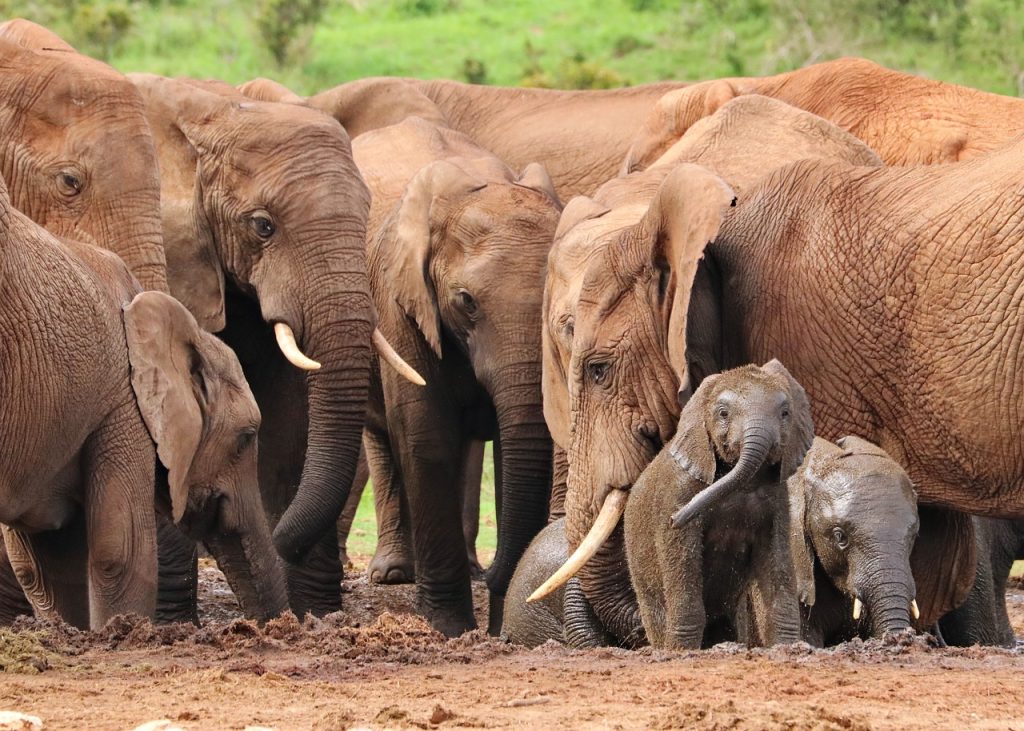
Reproduction, Babies, and Lifespan
As male elephants mature and reach sexual maturity, they undergo a significant physiological change known as musth. During musth, their testosterone levels skyrocket, surging to levels ten times higher than normal. This period is marked by aggressive behavior, enlarged temporal glands behind the eyes, and a continuous dribble of urine as they move. Musth serves to advertise the bull’s physical condition and readiness to potential mates and competitors alike. Bulls in musth often engage in battles with each other, although fatal outcomes are rare.
Females also signal their readiness to mate through various secretions. Once mating occurs, the female carries a single calf for an astonishing 22 months, longer than any other mammal species. Remarkably, the newborn calf is capable of standing and walking within an hour of birth. However, it still relies on the protection and care of the entire herd. If danger is sensed, adults emit loud trumpeting sounds, prompting the formation of a protective ring around the calves, with the herd facing outward to deter predators.
Despite the attentive care provided by the female herd, fathers play minimal roles in offspring development. It takes years for a baby elephant to fully grasp the intricacies of elephant life. Over the span of 13 to 20 years, they must hone their coordination, learn social nuances, and establish bonds within the herd. A well-reared crucial, as a poorly-raised individual may exhibit antisocial behavior.
Weaning takes a considerable amount of time, with calves fully weaned from their mother’s milk only after five or six years. During this period, calves gain an impressive 2 to 3 pounds per day in their first year alone. Upon reaching maturity, females typically remain with the herd, while males often depart to forge their own paths. In the wild, elephants can live well beyond 50 years, with the oldest recorded individual reaching an impressive 88 or 89 years old in captivity in India. Indian elephants are known to have longer lifespans compared to their African counterparts.
Population
According to the IUCN Red List, which serves as a crucial indicator of species’ conservation statuses, both the African bush elephant and forest are classified as vulnerable species. With only approximately 415,000 remaining in the wild, their populations have plummeted by about 90% since the early 20th century.
The situation is even more dire for the Asian elephant, classified as endangered by the IUCN Red List. With a population of only around 45,000 individuals and their habitats heavily fragmented, urgent conservation actions are imperative.
Conservationists are directing their efforts towards habitat protection and curbing poaching activities. International agreements, such as the 1989 ban on the ivory trade, have contributed to temporary declines in poaching rates. Furthermore, China’s ban on its domestic ivory market in 2018 has provided a significant boost to conservation efforts.
Conservation groups are also collaborating with local communities to mitigate negative human-elephant interactions. Initiatives include establishing corridors and safe havens to allow these magnificent creatures to roam freely without conflict.
However, due to their low birth rates and lengthy maturation periods, populations face challenges in replenishing themselves. The slow pace of population growth underscores the importance of sustained conservation efforts to safeguard these iconic species for future generations.
Elephants in the Zoo
Elephants are among the most iconic and beloved animals in zoos worldwide, yet due to their substantial food and space requirements, only a select few zoos have the privilege of housing them. Among these esteemed institutions is the renowned San Diego Zoo, renowned for its Elephant Odyssey habitat, which uniquely houses both African.
Several other esteemed zoos across the United States also provide homes for these majestic creatures. The Indianapolis Zoo, Maryland Zoo, Seneca Park Zoo, North Carolina Zoo, Los Angeles Zoo, Cincinnati Zoo, and Zoo Atlanta are among the privileged institutions that house elephants. These zoos are dedicated to providing exceptional care and spacious habitats for their resident contributing to conservation efforts and educating the public about the importance of protecting these magnificent animals.
Ending Words…
Elephants stand as remarkable and iconic symbols of the natural world. Their immense size, intelligence, and social complexity captivate and inspire awe in people around the globe. However, these majestic creatures face numerous threats, including habitat loss, poaching, and human-wildlife conflicts. Conservation efforts are crucial for safeguarding elephant populations and ensuring their continued existence for future generations to admire and cherish. By protecting their habitats, curbing poaching, and fostering harmonious relationships between humans we can work towards securing a brighter future for these extraordinary animals.
Reference:




